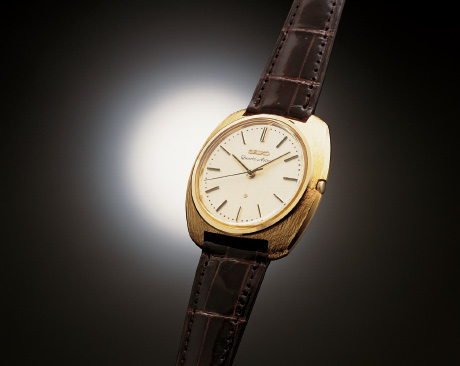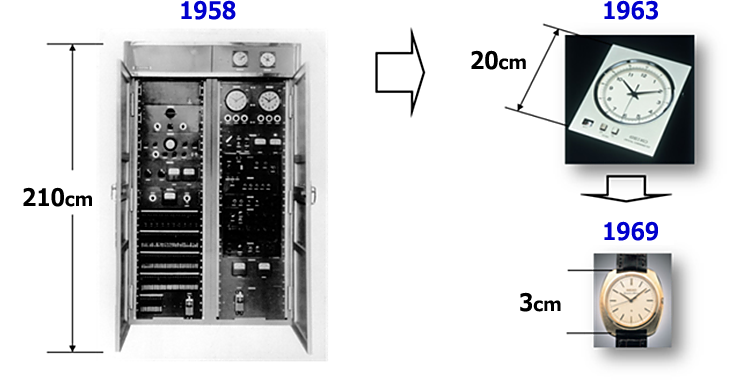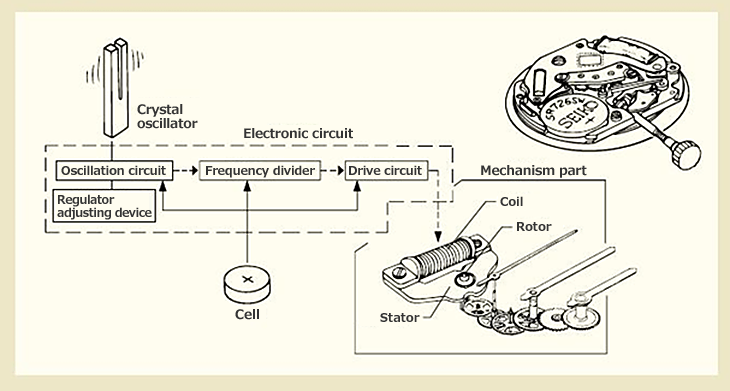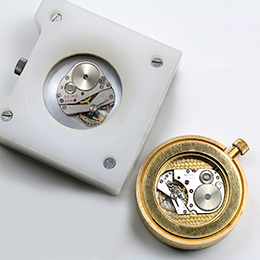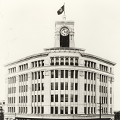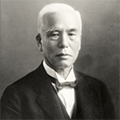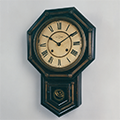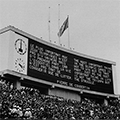~Seiko Quartz Astron received IEEE Award~
1. What is the IEEE?
IEEE stands for the Institute of Electrical and Electronics Engineers, Inc., the world’s largest association for electrical/electronics engineers, headquartered in the U.S.A. It is called IEEE (Eye-triple-E) and designated as a public-service corporation of the United States.
The AIEE (American Institute of Electrical Engineers) and IRE (Institute of Radio Engineers) merged to form the association in 1963.
The overall membership is now over 0.36 million around the world and includes about 12,000 members from Japan. The organization plays a leading part in technological development in fields such as computer science, biotechnology, communication, electric power, aviation, and electronics.
The expert committees are organized and serve members by organizing international conferences, the publication of papers, technical education, and standards.
< Main Awards >
IEEE Corporate Innovation Recognition Award
An honorable award sent to organizations and companies that have contributed to the development of electrical and electronics industries through the development of innovative products and systems. The Award was established in 1985. Winners receive a glass trophy.
IEEE Milestone Award
The Milestone Award is received for revolutionary historical innovations in fields covered by IEEE activities such as electricity, electronics, and information and communication. To win, a technology must be recognized to have contributed to the development of society and industries for at least 25 years. The Award was established as the Electrical Engineering Milestone in 1983 to publicly praise the achievements and was renamed IEEE Milestones in Electrical Engineering only recently, in 2000. The purpose is to enhance society’s recognition and praise for engineers who have developed excellent technologies.
When a Milestone is selected, a plaque is engraved with the achievement and put on display.
2. “Seiko Quartz Astron,” the World’s First Electronic Quartz Watch, received both the IEEE “Corporate Innovation Recognition Award” and “Milestone Award”
| Name | Seiko Quarts Astron |
|---|---|
| Release | December 25, 1969 |
| Price | 450,000 Yen (18K gold-cased) |
| Movement size | Outer diameter 30.00mm Thickness 5.30mm |
| How to drive | Quartz oscillator, step motor by a drive circuit |
| Quartz frequency | 8,192HZ (vibration) |
| Accuracy | Daily difference ±0.2 seconds monthly difference ±5 seconds |
2002 Corporate Innovation Recognition Award: Seiko Epson Corporation
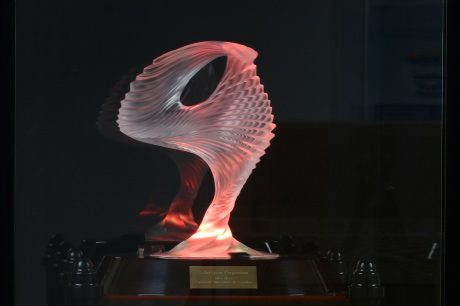
The watch was incorporated with a turning fork crystal oscillator, an IC for watches, and an open step motor. The development of quartz wristwatches contributed to the development of power-saving technology in the entire electronic device industry, the highly appraised innovation that earned Seiko the award. The trophy is kept display in the “Monozukuri (Manufacturing) Museum” located in the head office of Seiko Epson Corporation in Suwa-city, Nagano.
2004 Milestone Award: Seiko Epson Corporation Nakamura Team
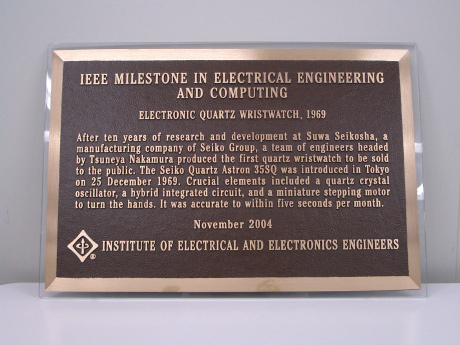
News about the release of the “Seiko Quartz Astron” line of electronic quartz wristwatches spread all over the world. Since the daily difference of mechanical watches was ±20 seconds at the time, Astron’s precision, a daily difference of ±0.2 seconds (monthly difference within ±5 seconds), was a revolutionary surprise for the whole world. Seiko Group developed mass production methods while focusing on technological improvements such as “high precision,” “slimming and downsizing,” “multi-functionality,” “electronization,” etc. for the spread of quartz watches. The publication of technological patents for the “tuning fork crystal oscillator,” “open step motor,” and other innovations greatly contributed to the further spread of quartz watches in ensuing years. At present, 97% of the world’s wristwatches are driven by quartz movements. The Seiko Method is a world standard. Seiko held training courses worldwide for sales staff and service personnel and promoted the construction of an after-service system to further the electronization of technology.
The plaque was received on November 25, 2004 in the same year soon after the award was announced and is now displayed in the Seiko Institute of Horology (currently the Seiko Museum) throughout the year.
Records of Milestone Award Recipients (English)
3. Important technologies in Seiko Quartz Astron
The watchmakers of the world vied to achieve new advances in “high-precision” and “electronization” in the 1950s. Suwa-Seikosha (currently Seiko Epson Corporation) started a project team led by Tsuneya Nakamura to develop quartz wristwatches. Various large clocks incorporating crystals were developed as standard clocks for broadcasting stations, ocean-going vessels, and observatories in Japan and overseas. The development of new technology was essential for the further downsizing and commercialization of wristwatches. There were mainly three challenges.
-
STORY 01
Downsizing and stabilization of crystal oscillators → Development of the tuning fork crystal oscillator
-

(Left) crystal and (right) tuning fork crystal oscillator The switch to tuning fork crystal oscillators from the conventional bar type led to further miniaturization, strengthened durability against shock, and the production of more stable frequencies. The development of manufacturing technology (Photolithography) to process crystal into a turning fork form contributed to mass production of high precision ultra-small oscillators.
-
STORY 02
Power saving → Development of the CMOS-IC
-

CMOS IC The first quartz wristwatch (35SQ) utilized a hybrid IC by a transistor. Later on, Seiko manufactured CMOS-ICs driven by low power of 1 out of 3 or 4 compared with regular ICs in house and realized downsizing and low power consumption of circuits.
-
STORY 03
Power saving and downsizing of motors → Development of the open step motor
-

power saving. To fit a mechanism within a size of diameter 30.0mm and thickness of 5.3mm, Seiko developed an open step motor consisting of a rotor and stator installed separately as main structural components between the wheels and adopted a method to advance the second hand at just one step per second. This 'just one step per second' motion contributed a lot for
Seiko group “downsized” the movement for quartz watches to 1/300,000 in volume in 10 years.
Mechanism of ordinary quartz wristwatches
4. Seiko Quartz Astron – another harbinger of the information society
Nowadays, we think of quartz wristwatches as a ubiquitous tool for convenient everyday life. The same technology is use for LCD digital watches, the radio clocks and GPS wristwatches now booming. Turning fork crystal oscillators are used for a wide range of electronics such as PCs, mobile phones, smart phones, digital cameras, etc., as well as watches. All of these devices are shaping our networked society.
Links/References
History of Seiko wristwatches (Seiko Watch Corporation) (to Japanese language site)
・SEIKO’s folded leaflet “Seiko Quartz Atron,” which changed the history of wristwatches”
・Suwa Seikosha Company newsletter
・WEB/IEEE Japan OFFICE
・WEB/IEEE Kansai Branch
・Seiko Epson Corporation website


